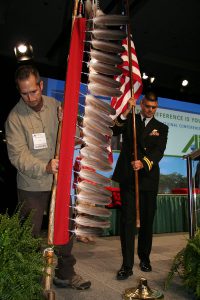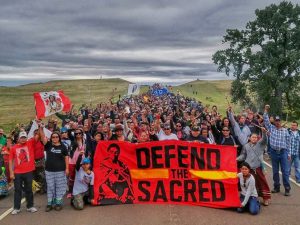Passed in 1978 and amended in 1994 the American Indian Religious Freedom Act, or AIRFA, re-emphasizes the First Amendment right to freedom of religion for the indigenous people of what is now the United States. The law aimed to rectify the centuries of religious oppression by the federal government which destroyed native sacred sites and forcibly removed people from their ancestral lands. The main aspect of the law had to do with public lands the secondary conflict focused on items traditionally used as ceremonial items that are illegal to possess such as eagle feathers or peyote, which is classified as a drug. The act also tells federal agencies to work directly with American Indian spiritual leaders to further protect their first amendment rights.
It is important to recognize that this act admitted fault in the actions of the federal government in its treatment of Native people, spaces, and rituals. But because of the lack of definition of terms the act was hard to enforce and use. It does not protect specific sacred sites such as the Black Hills or the sites associated with the Standing Rock Sioux and the Dakota Access Pipeline.
The 1994 amendment defined terms such as “Indian” and “Indian religion” but these terms themselves are not indigenous to the people and cultures the describe. Most native cultures in the Americas did not have clear definitions of religion or distinctions between religious practice and cultural practice in the way that Protestant Europeans understood them. For this reason, discerning exactly what pertains to “Indian religion” is next to impossible. Even the definition in the amendment is vague: “(3) the term ‘Indian religion’ means any religion – (A) which is practiced by Indians, and (B) the origin and interpretation of which is from within a traditional Indian culture or community.”

Recently the Act has been used by groups like the ACLU to help incarcerated native people get access to religious objects like eagle feathers. It would be interesting to see how this act could be applied to the Dakota Access Pipeline protests, but it would be hard to argue the case. This is mainly because Native conceptions of sacred spaces are so different than Protestant and Eurocentric ideals. We think a site is only sacred if it has a temple or church or something like that. Native spirituality is inherently tied to the land and the history of the land, not the structures built on that land. In this way the land itself is sacred and therefore hard to protect in a capitalist society. An updated and stronger version of AIRFA would have to encompass this definition of sacred and worldview.

Sources:
“ACLU To Fight For Religious Freedom Of American Indian Incarcerated In Wyoming.” American Civil Liberties Union. N.p., 9 July 2008. Web. 14 Feb. 2017. <https://www.aclu.org/news/aclu-fight-religious-freedom-american-indian-incarcerated-wyoming>.
Barkhausen, Matt. “Sacred Sites Destroyed: Dakota Access pipeline workers destroy Native American sacred site.” Blasting News., 08 Sept. 2016. Web. 14 Feb. 2017.
Buhl, L. (2016, September 6). Destruction of Sacred Burial Grounds Prompts Federal Judge to Protect Some Tribal Sites from Dakota Access Pipeline. Retrieved February 14, 2017, from https://www.desmogblog.com/2016/09/06/dakota-access-pipeline-sacred-sites-federal-judge
Eagle feather law. (2016, December 23). Retrieved February 14, 2017, from https://en.wikipedia.org/wiki/Eagle_feather_law
“Possession of Eagle Feathers and Parts by Native Americans.” Fish and Wildlife Service, Web. 14 Feb. 2017. https://www.fws.gov/eaglerepository/factsheets/PossessionOfEagleFeathersFactSheet.pdf
